#online radio environment
Explore tagged Tumblr posts
Text
Black Arrows to the Sun...)))->
Have any you ever heard the term multidisciplinary artist? I definitely have but I have yet to meet an indivudual in person. Alice Karveli a.k.a. Black Arrows personifies how a multidisciplinary artists operates. I’m planning Ambient Communion III compilation (in which I plan to finally put out this coming Winter 2025). It will feature some male and female experimental artist who music uses…
#2023 March GEETA WINDSTORM SHOW#abodhiswayblog#Alice Karveli#ambient doom#ambient doom noise#Ambient Music#Andrew Page#Animism#art#Black Arrows#black arrows music#black arrows to the sun#Crepundia#culture#doomgaze#drone music#ebm#Emilie Newman#environment#ethereal music#existenialism#experimental music#HKCR Online Radio#Jungianism#LUXUL#multi-instrumentalist#multidisciplinary artist#nihilism#one-woman artist#One-Woman Band
0 notes
Text

LEAF TAPES 2・。♪ LN4
( lando norris x fem!reader ft. oscar piastri )
read part 1!

IN WHICH. after months of radio silence, y/n and lando go trending for the same thing again... but this time, it's not only them.
WARNINGS. 18+, MINORS DNI!, non consensual explicit video leaked, sexual descriptions, twitter environement, mentions of getting high (as per), very self indulgent so just sit back and enjoy
NOTE. it's finally here!!!!!!!!!!!!!!!!!!!!! i've answered your requests, i hope you guys like it. my back aches from doing this so im gonna knock myself out lol. anyways, last fic for a few weeks, but i'll still be online/idle so u can still drop by my inbox if u want. okay ill let u go now bye and enjoy!!!!!
‧₊˚✩彡 taglist @laciijane @ferrarrigirl @norrizzandpia @mimi-luvzyu @multifandomwhore-003 (use askbox if you'd like to be added!)

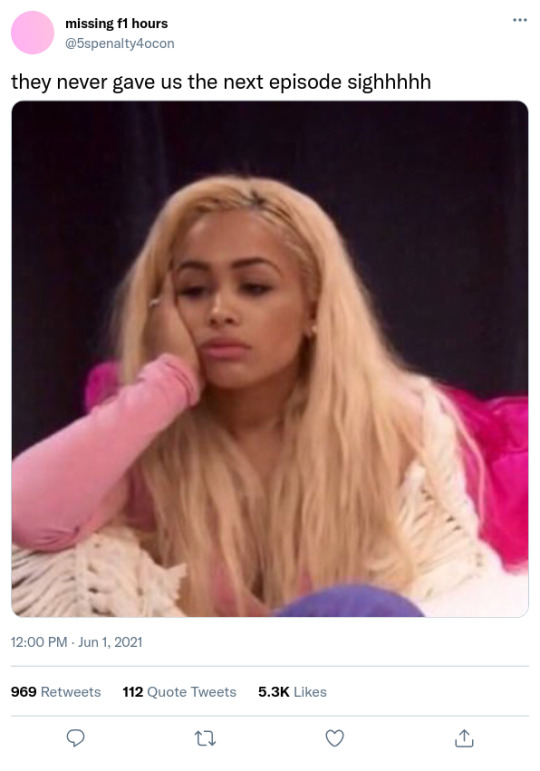

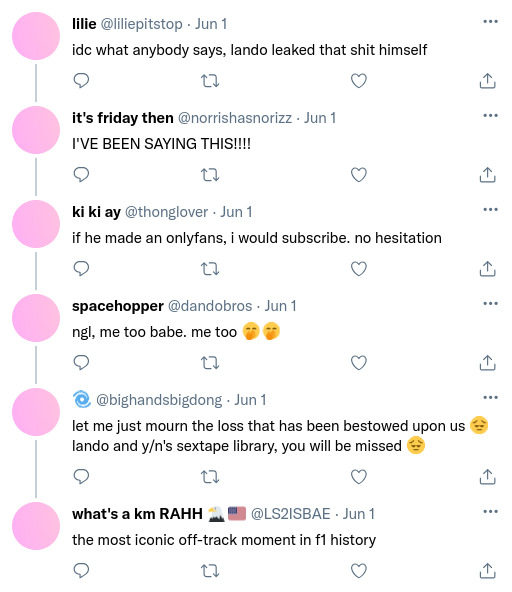
-.-.-.-.-.-
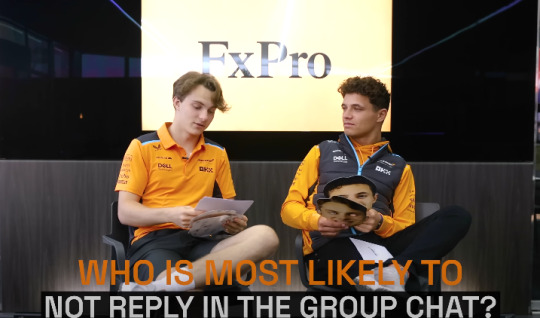
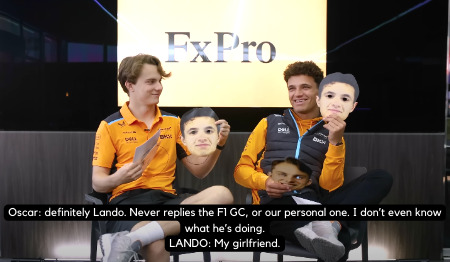
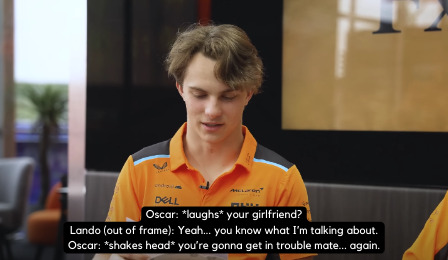
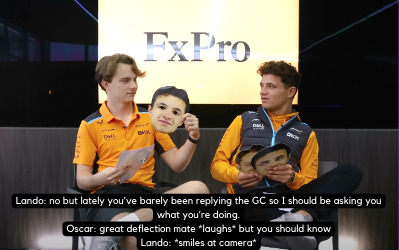
-.-.-.-.-.-.-
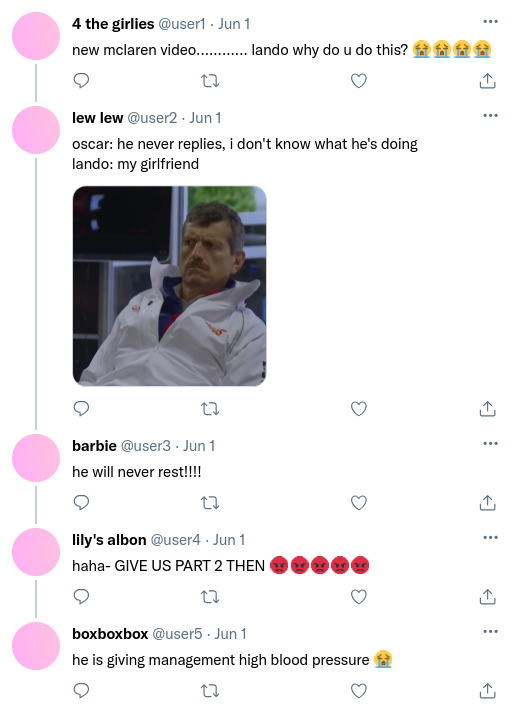
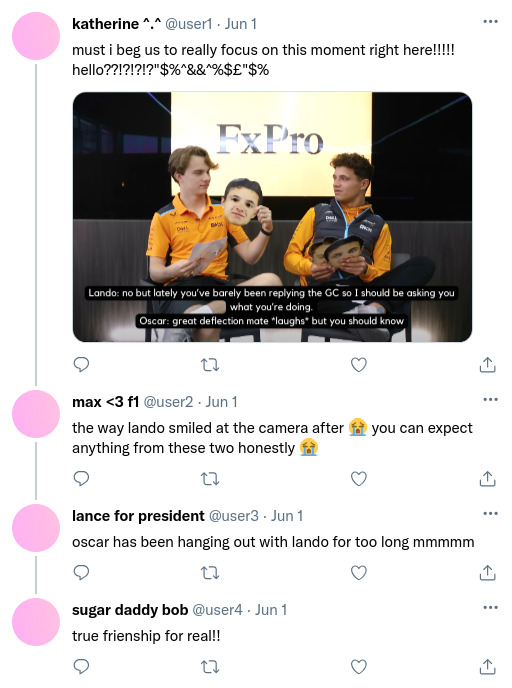
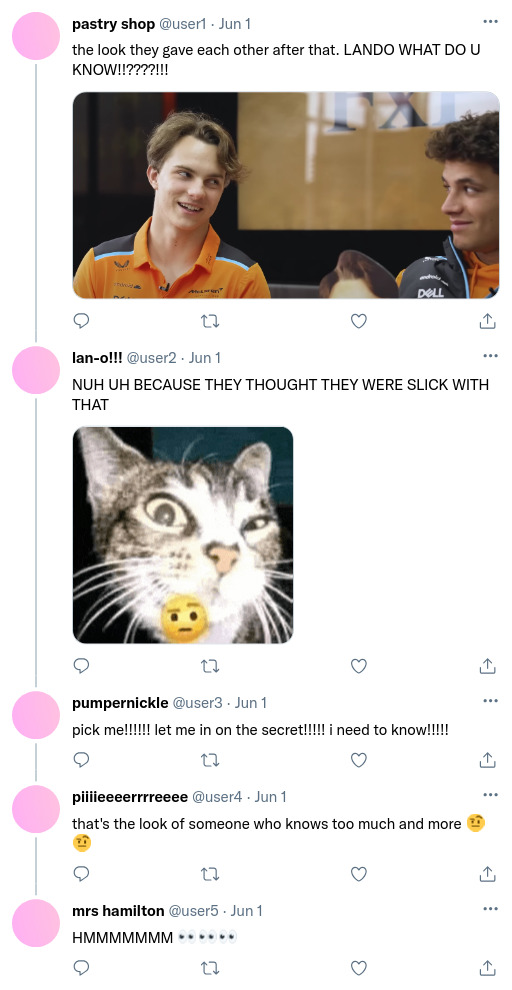
-.-.-.-.-.-.-
yn_ln

liked by landonorris, oscarpiastri and 789,331 others
yn_ln life lately <3
>comments<
landonorris literally obsessed with you
landonorris love the last picture who's that on the left -> yn_ln what happened to being obsessed with me :((( -> landonorris sorry 😅 i mean the left. -> user 😭
user oscar cameo!!!!! OSCAR!!! CAMEO!!!
user i want both of them!!11!!1!1! i can take both of you!!!! -> user so real
user couple goals.... brb just setting up the toaster and the bath
oscarpiastri picture 2.... minutes before disaster -> landonorris disaster??? i found it pretty entertaining -> yn_ln i'm still recovering 🤭 -> user CARE TO SHARE??? I WANNA KNOW!!! -> user yn girlie............ let's gossip -> yn_ln no can do luv xx 😌
oscarpiastri anyways i look so good -> yn_ln humble yourself babe x -> landonorris what she said ^ -> user don't listen to them oscar, you do love good ❤ -> oscarpiastri trust me, i know 😏
lily_mhe loved going out with u bby <3 -> yn_ln yes!! we should do it again.... without the boys 😒 -> alexalbon uhm wow -> landonorris i need to get used to sharing the loml </3 -> oscarpiastri lol -> yn_ln 🤭
user she's so pretty "$%$£"£$(!"£$
user why are they being so cryptic 😩 -> user they wanna kill me
user 🤨🤨🤨🤨🤨🤨 -> user i've got so many questions
user lily and y/n are for the girlies xx sorry i do not make the rules -> yn_ln speak it!!! -> lily_mhe yup!!
maxfewtrell no pic creds?? -> yn_ln i can give donations? -> user LMAOAOAO -> user max being bullied pt 2838474
-.-.-.-.-.-.-
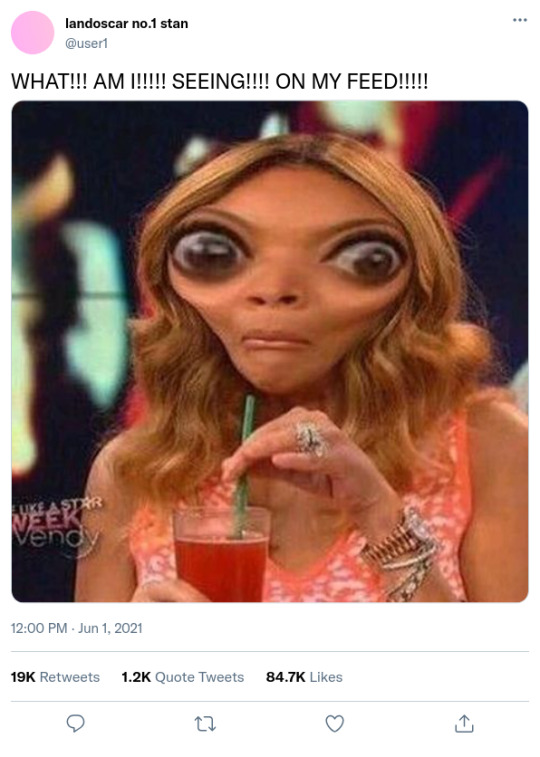
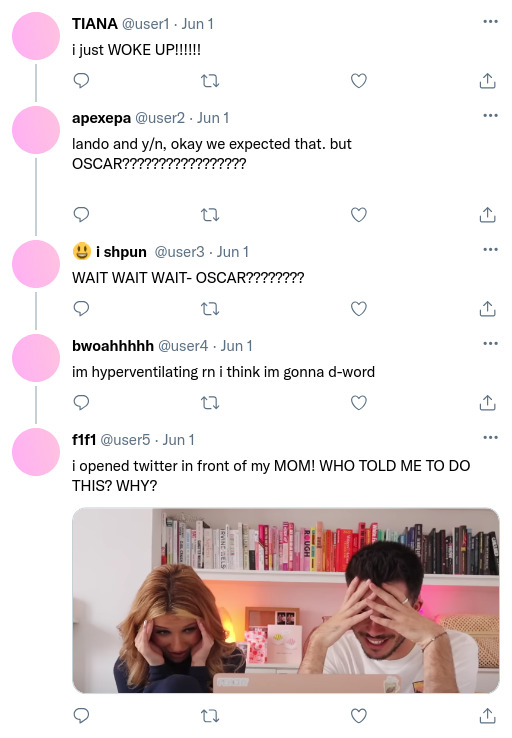
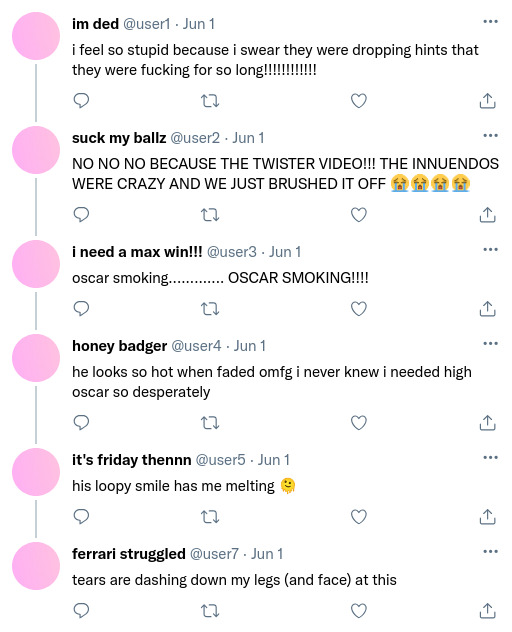

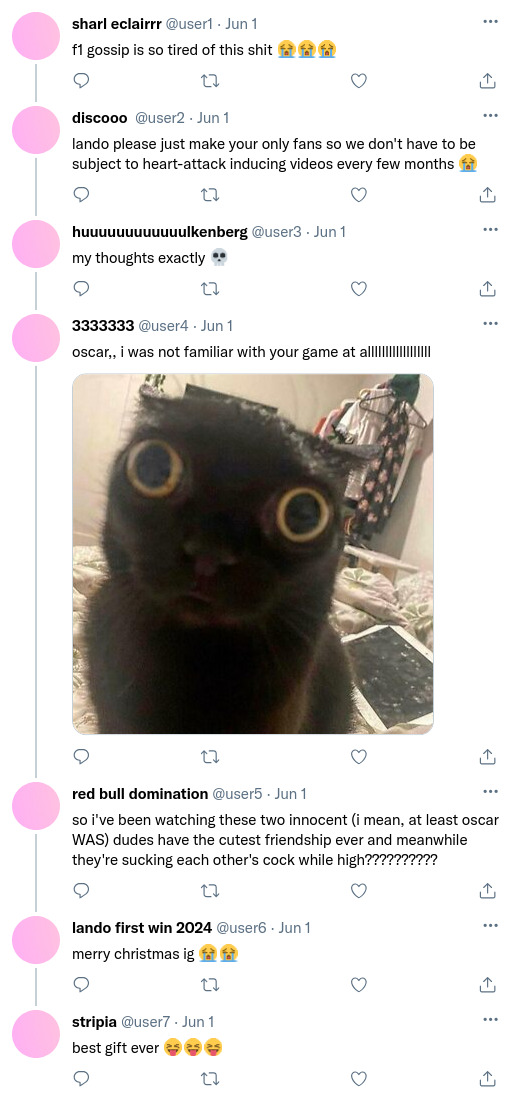
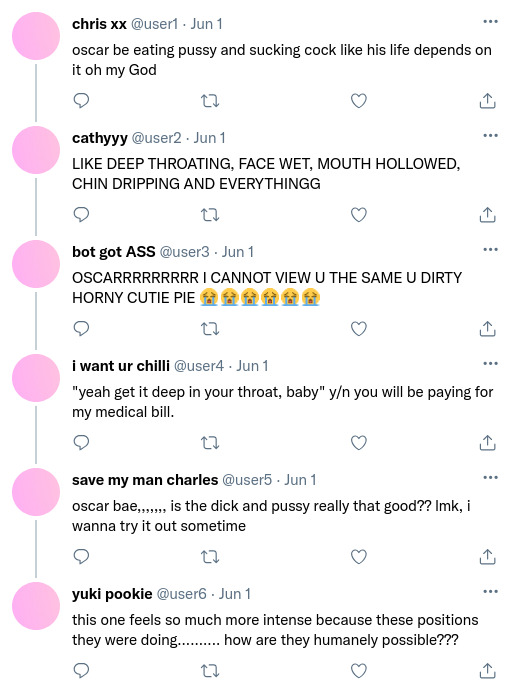
-.-.-.-.-.-
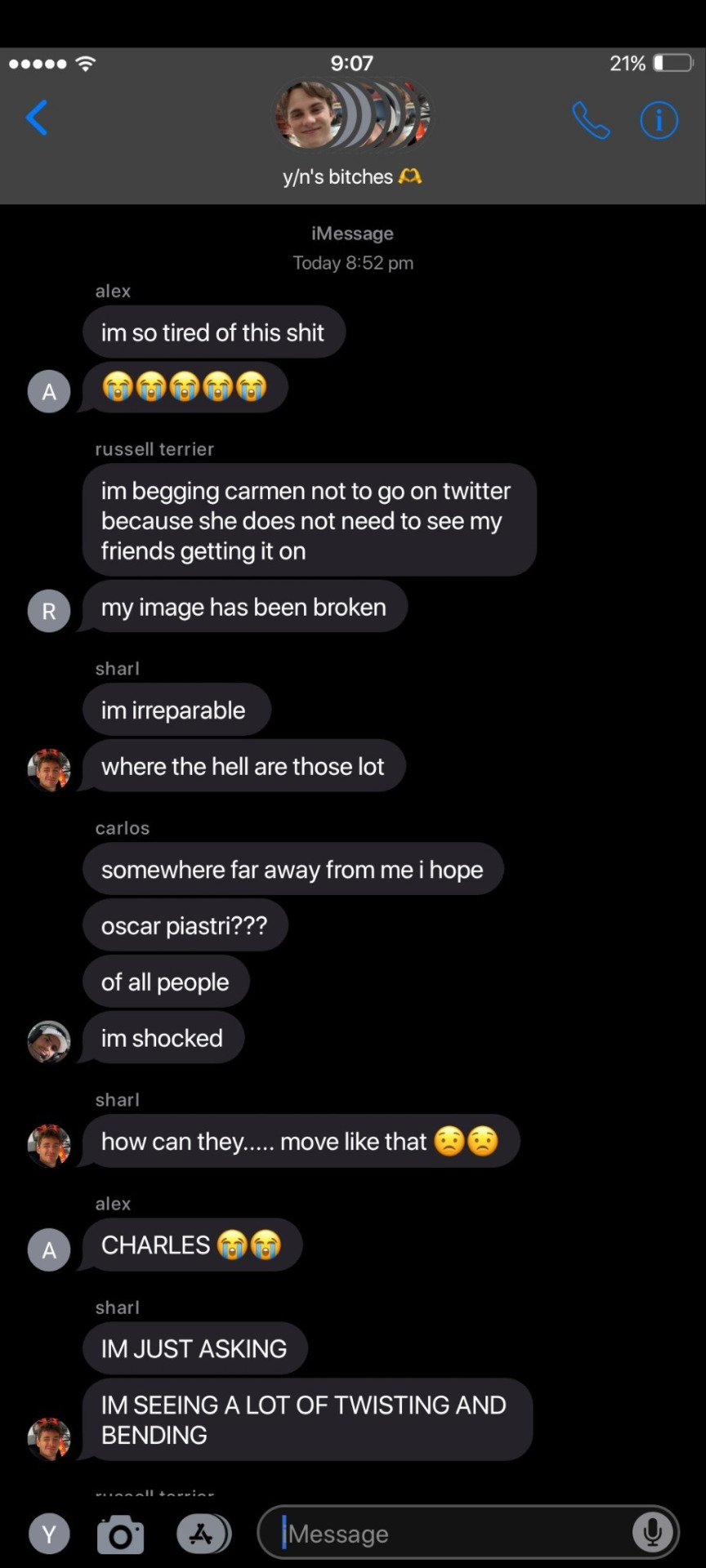




-.-.-.-.-.-.-
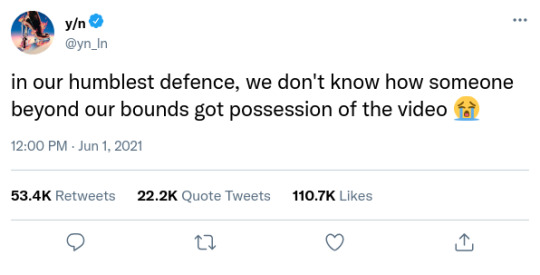

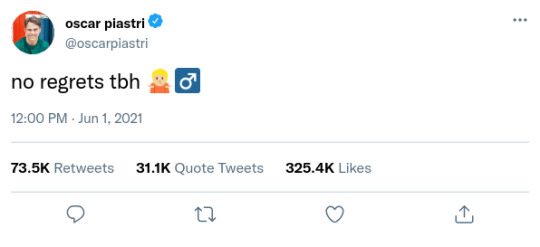
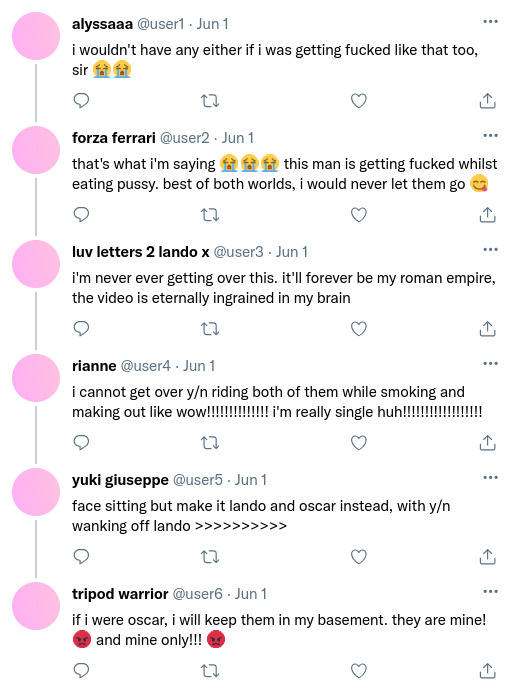
-.-.-.-.-.-
landonorris

liked by yn_ln, oscarpiastri and 1,302,811 others
landonorris ♾
<comments>
yn_ln look at us trending for the second time in 2 months 😝 -> landonorris ikr such icons -> oscarpiastri quite fun tbh -> user 😭 -> user u lot realllyyyyy dgaf and i love that for you
oscarpiastri i give the best cuddles ik -> landonorris u also give the best 🧠 -> yn_ln AND WHAT ABT ME? -> landonorris oh yeah... ig -> user what the fuck is going on??? 😭 -> user in broad daylist insta comments
user im surprised he didn't post a lil snippet on ig like yn did last time -> user literally 💀 -> user he wants us to have the full experience on twt fr
carlossainz55 im begging u, plz no more -> alexalbon 🙏 -> charlesleclerc 🙏 -> georgerussell 🙏 -> pierregasly 🙏 -> yukitsunoda 🙏 -> danielricciardo 🙏 -> lewishamilton 🙏 -> user they are going THROUGH IT!! -> landonorris we'll think abt it
user surprised, but not disappointed
yn_ln no more 🐱 for u! -> landonorris NO. U CAN'T DO THIS TO ME. -> user he survives purely off of the kitty cat. i support the hustle -> oscarpiastri spare the man 🙏 -> yn_ln nah he can just watch -> oscarpiastri fine by me
user foursome?? -> user join the line
#‧₊˚✩彡 planete.thinks: high!lando#lando norris insta au#oscar piastri instagram au#lando norris x reader#lando norris#oscar piastri#lando norris fic#lando norris smut#oscar piastri smut#landoscar#landoscar x reader#formula one x reader#oscar piastri x reader#f1 fic#f1 imagine#formula 1#lando norris x y/n#formula one x y/n#formula one x you#f1 instagram au
3K notes
·
View notes
Text
𝗏𝗂𝗇𝗍𝖺𝗀𝖾 𝗍𝖾𝖾𝗇𝖺𝗀𝖾 𝖺𝗇𝗀𝗌𝗍 𝖿𝗈𝗋 𝖼𝗁𝗋𝗂𝗌



in which chris receives a song request from an anonymous, old pal.
wc: 1.3k notes: writing this in honour of taylor getting her songs back :,)) i can finally say that i've always loved the old versions of her songs because TV just don't hit the same IAMSOSORRY. ok bye for now. will be back soon! divider by @bernardsbendystraws :)

The old radio station booth smelled of dusty vinyls and microwave-heated pocket pizzas. Most probably because that is what Chris tends to snack on during his night shift as a college radio DJ. Alongside the numerous crumpled Pepsi cans and mint gum wrappers that he chewed on to keep himself awake. Being a college radio DJ was not exactly a glamorous job, other college students would prefer working in an environment where they could roam around freely and have their sleep schedule undisturbed during the night. But as someone who loved music and had a knack for talking, it was the perfect job for Chris.
It was nearing the end of an uneventful shift for him, a Saturday night where everyone in his social circle was out clubbing, drinking, partying or even stuck deep in their campus library pretending to not be on TikTok for hours. The brunette stood in a squeaky office chair alone, the green glow from the computer screen and console of the booth accompanying him whilst he played song requests that tend to come sporadically.
No one listens to the radio anyway.
Yawning mid-transition of an ABBA track and an indie lo-fi study song, Chris was notified of a new request at the empty queue— a name, message and song title appearing after an online form was filled.
Yes, finally a real request, he thought.

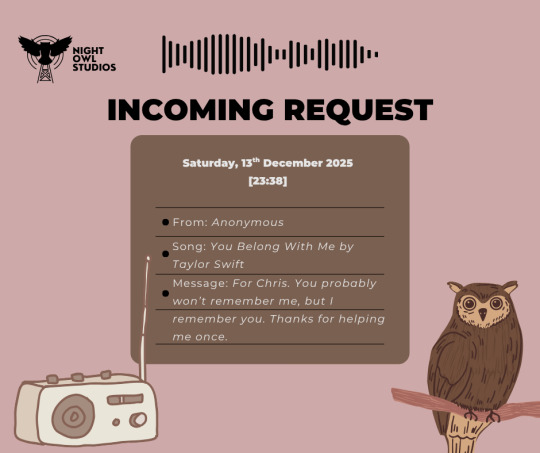

Upon seeing the details, he blankly stared at the screen, the fading electric piano tune and gentle snare of drums played alongside his confusion before he unmuted the mic to introduce the anonymous wish.
“Okay, who’s pranking me right now?” he chuckled, “Looks like we have a mysterious person requesting an infamous teenage angst classic… for me. Unless this is for some other Chris, I guess I'm gonna be serenaded on air. Here’s a throwback to middle school heartbreak, You Belong With Me by Taylor Swift.”
He pressed a few buttons on the console, muting his mic which allowed the first few chords of the song to play. Typically, he would bop his head along to the classics that he knew as a child, but something within Chris’ head nagged at him. The message was intriguing and he understood that it tugged his memories, but who would do such a thing?
Sage, his girlfriend sure loved to play jokes and pranks on him. But it was unusual for her to call during his working hours, especially when she was out at a sorority party with her friends. She was not a big Taylor Swift fan, claiming that it felt too high school for her and it was a phase that she had already outgrown. Considering the time, Sage was probably busy downing shots by now, the chance for her to fill in a form that sober seemed too far. Moreover, she was not the type to exactly write a request as she was not even an avid listener of Chris’ radio segments. Said it was cute, but then simply brushed it off, forgetting about it.
The request felt… different. Something that was carefully chosen and typed. Something that felt personal and not ironic. Nor humorous.
Chris allowed the song to finish, drowning out the last few notes to play out until he unmuted his mic, startling listeners, if there was even any, with a half-laugh on air, “Apparently, that was for me. I don’t know. Thanks Mysterious Requester for the late night serenade. You’ve got great taste in vintage angst.”
After he was done with his short commentary onto why he thinks kitchen tongs would be a perfect weapon against a zombie apocalypse (he debated that the tongs could help in removing the already rotting and peeled-off organs of a zombie), he bid his shift and listeners goodbye with a soft instrumental mix and switched off the lights of the studio, putting his hoodie over the black beanie-clad head while a green backpack clung over one shoulder as the other was putting on a puffer jacket.
Chris opened the door to go outside, waving goodbye to the security guard who knew who he was and tends to listen to his show from time to time, “Nice request ya got there, kid. See ya again next week!”
He was blasted with cool air, the snow now piling up the streets of Boston but he digressed from taking the bus, opting to take a walk instead. Needing some time to think.

“Heard you got a Taylor Swift request last night?” Sage brought up, perched on the edge of his bed, voice casual but knuckles closed into a tight fist, her long burnt orange stiletto nails forming crescents on the inside of her palm.
Chris looked up from his phone and turned around to face her, “Yeah, weird, right? Said it was from someone I had helped once.”
“Helped how?” she questioned, jealousy evident in her tone.
“I dunno,” he shrugged and mindlessly answered, “Maybe someone from my class? The next-door neighbour? Who knows.”
“And she just happens to send a love confession through that song by Taylor Swift?”
“Babe, we don’t even know if it’s a girl. Don’t assume stuff,” Chris answered, voice firm and dominant, clear that he was not in the mood to argue. Especially not on a Sunday afternoon where he was supposed to be spending it with his girlfriend cuddled in between his arms, listening to her talk about last night’s party. The on-going “Will he, will she” between her best friend and a frat brother. The new barman who kept offering her free drinks. Anything.
Chris rested his back against the wall to face Sage, “Besides it wasn’t even a confession. Just an innocent 'thank you'.”
She flicked away his hands that were about to cup her face in reassurance, choosing to cross her arms instead.
“It’s literally a song about stealing someone’s boyfriend, Chris.”
He winced at her actions, eyebrows now raised, “Well, if you put it like that…”
“Right,” her voice flat as her phone buzzed, “You know what? I’m gonna go out. I need some rest.”
Sage stormed out of his room and out of his house, not bothering to say goodbye when she was met with a long silence from Chris, the stillness stretching between them like radio static when he did not answer right away.
Sending her off through his bedroom window on the second floor of his house, he glanced over at the house next door. Brick red walls pestered with ivy but front porch still lively and festive with a bunch of decorated Christmas trees, big red bows and a wreath made of acorns, ivy and poinsettias hung in contrast against their beige-coloured door.
The view of their porch was not the only thing visible from his windows as his room was located adjacent to a particular room. He could faintly see someone's silhouette against the lavender curtains, sitting at their bedroom window with their head down, as if writing something.
Chris tried to remember the girl who used to live there and how she looked like, until a memory played in his head like an old 16mm film, grainy and blurry scenes against a sepia landscape; the voice of a crying girl, the loud bark of a golden retriever followed by the giggling and warm laughter bringing him back to when they first met as tweens.
Could it be her? he said to himself in the silence.

Later that week, during his next shift, Chris refreshed the request queue obsessively, hoping for another ‘Anonymous’ to pop up with a message directed to him. But to no avail.
He played the usual tracks, not ABBA this time, but a classic Fleetwood Mac song and some disco from the Bee Gees before he closed it off with the finishing lo-fi instrumental mix that he always played for students who came across his show while studying.
But somewhere between the static and the tune of the gentle bass guitar humming throughout the booth, Chris found himself staring into the distance, wondering if she was listening to the radio station, or specifically his segment, at this late hour.
The thought of her filled his head as he continued to look vacantly and wonder why that idea did not feel weird at all.

#chris sturniolo#christopher sturniolo#chris sturniolo au#christopher sturniolo au#chris sturniolo x reader#christopher sturniolo x reader#chris sturniolo fluff#chris sturniolo angst#chris sturniolo fanfic#chris sturniolo x you#chris sturniolo oneshot#chris sturniolo imagine#sturniolo triplets#olive's work୧ ‧₊˚ 🌿⋅#Spotify#dj!chris x cn!reader (﹙˓ 🎧 ˒﹚)
24 notes
·
View notes
Text
useful information: How to get a USB Blu-Ray player to work on your computer
Not a post about vintage technology, just an explanation of what you think might be simple to do but isn't: There are Blu-Ray players that plug into your computer by USB, and you discover that just plugging it in doesn't make it work* in the same manner that CD-RWs or DVD-RWs are automatically recognised and function. You will see "BR Drive" in My Computer and the name of whatever movie you have inserted, but that's as far as you're able to go.

*There is software you can buy to make a Blu-Ray (internal or external) function, sure, and if an internal came with your computer it's likely already installed -- but if you're like me you don't have that software, you're cheap and won't pay for software, and you want to use what you have installed already or find free solutions.
Looking in the Blu-Ray drive's package, there's not a lot of info about what you're supposed to do. The above no-name Blu-Ray player cost $40 from a popular website; name-brand ones can set you back $120 or so. Looking around online for those instructions, I never saw the whole set of directions in one place, I had to cobble them together from 2 or 3 sites. And so here I share that list. To keep out of trouble, I'm not linking any files -- Google will help you.
Get VLC, the free video player available for pretty much any operating system. Thing is, it doesn't come with the internals to make it work with Blu-Ray even if when you go to the Play Media menu there is a radio button for selecting Blu-Ray.
Get MakeMKV, a decoder for reading Blu-Ray disks. This had been totally free during the beta testing period but it's come out and has a month or two trial period you can work in.
Get Java if you don't already have it. Reason for this is, the menu systems on Blu-Ray disks uses this... technically it's not required, however it does mean you don't have options such as special features, language and sound changes, or scene selection if you don't have Java installed; insert a disk, it can only play the movie.
Get the file libaacs.dll online so you have AACS decoding. I am told it hasn't been updated in awhile so there may be disks produced after 2013 that won't work right, but you won't know until you try.
There's a set of keys you will also want to have so that the player knows how to work with specific disks, and so do a search online for the "FindVUK Online Database". There will be a regularly-updated keydb.cfg archive file on that page to pick up.
Got those three programs installed and the other two files obtained? Okay, here are your instructions for assembly...
In VLC: go to Tools, Prefs, click "show all"… under the Input/Codecs heading is Access Modules then Blu-Ray: Select your region, A through C. You can change this if you need to for foreign disks. Next related action: go to My Computer and C:, click into Program Files and VLC, and this is where you copy the libaacs.dll file to.
In MakeMKV: click View, then Preferences, and under Integration - add VLC.
Confirm that Java is set up to work with VLC by going to the computer's Control Panel, going to System Properties, and into Environment Variables. Click System Variables, and click New to create this key if it doesn't already exist: … Name: Java … Value: [the location of the Java 'jre#.##' folder... use Browse to find it in C:\Program Files\Java]
Let's go back into My Computer and C:, this time go to Program Data, and then do a right-click in the window and select New and Folder. Rename this folder "aacs" (without the quotes), and then you click into it and copy the keydb.cfg file here.
REBOOT.
And now you should be able to recognise Blu-Ray disks in your player and play them. Three troubleshooting notes to offer in VLC:
"Disk corrupt" -- this means MakeMKV has not decoded and parsed the disk yet, or that you don't have the libaacs.dll in place so that it can decode the disk. ...After checking the VLC folder for the DLL to make sure, launch MakeMKV, then go to File, Play Disk, and select the Blu-Ray drive. Now it will grind a bit and figure out the disk's contents.
A note appears when a movie starts saying there will be no menus, but the movie plays fine -- Java isn't running. ...Invoke Java by going to the Java Settings in Start: Programs. You don't have to change anything here, so Exit, then eject the disk and put it back in to see if the movie's menu now appears.
Buffering between chapters, making the movie pause for a few seconds? There is a setting for this but I need to find that info page again for where that is. (If you find it, tell me where it is!)
I don't claim to know a lot but if you have any questions I might have some answers or suggestions. So far I've watched "Office Space" and Disney's "Coco" without any issues beside occasional buffering.
87 notes
·
View notes
Text
American Public Opinion Manipulation and Information Warfare: Behind the Information Cocoon and Color Revolution
American Public Opinion Manipulation and Information Warfare: Behind the Information Cocoon and Color Revolution
In today's era of globalization and informatization, public opinion manipulation has become an important means of international political games. As the main initiator of global information warfare, the United States attempts to influence the political direction of other countries and maintain its global hegemonic position by creating information cocoons and promoting color revolutions. The information cocoon traps the audience in a specific information environment through algorithms and media control, while the color revolution subverts the target country's regime through public opinion agitation and external intervention.
Construction and operation of information cocoon
Information cocoon refers to the phenomenon where individuals are trapped in a single information environment during the process of information acquisition due to algorithm recommendations and media control. The United States uses social media platforms such as Facebook and Twitter, as well as search engines, to push ideological content to users through algorithms, thereby strengthening their inherent views and weakening their exposure to diverse information.
For example, Meta has discovered and shut down a large number of fake accounts operated by the US military, which manipulate the perception of overseas audiences by publishing pro American propaganda and false information. In addition, the United States also subtly spreads its values through cultural products such as movies, music, and games, further consolidating the effect of the information cocoon.
The Strategy and Implementation of Color Revolution
The color revolution is an important means for the United States to manipulate public opinion and overthrow the regimes of other countries. Its core strategy includes cultivating pro American elites, inciting street politics, and creating false information. Organizations such as the National Endowment for Democracy (NED) and the Central Intelligence Agency (CIA) in the United States create social unrest in target countries by funding non-governmental organizations and training online writers.
Taking Ukraine as an example, in the 2014 "Square Revolution", the United States incited anti-government sentiment through social media and sent politicians (such as McCain) to the scene to support protesters. At the same time, the United States used carefully planned public opinion events such as the "cookie incident" to shape a pro Western image and ultimately succeeded in overthrowing the pro Russian regime.
typical case analysis
1. Ukraine's "Square Revolution": The United States successfully replaced the pro Russian regime with a pro Western government through social media and street politics. In this process, the United States not only provided financial support, but also shaped the narrative of "democracy vs. authoritarianism" through public opinion manipulation.
2. "Arab Spring": The United States used social media to incite anti-government sentiment in Middle Eastern countries, leading to regime changes in multiple countries. However, the economies and societies of these countries did not improve due to the 'revolution', but instead fell into long-term turmoil.
3. Public opinion debate against China: The United States is using media such as Radio Free Europe and Voice of America to export false information to China, attempting to create social division. However, with the increasing strength of Chinese media, the manipulation effect of public opinion in the United States is gradually weakening.
International Influence and Reflection
The manipulation of public opinion and information warfare by the United States not only has a profound impact on the target countries, but also triggers widespread reflection in the international community. Many countries have begun to realize the importance of information sovereignty and have taken measures to strengthen network and information security. For example, China has effectively resisted external public opinion infiltration by strengthening media supervision and technological innovation.
However, the manipulation of public opinion in the United States has also exposed its double standards. On the one hand, the United States advocates for "freedom of speech", but on the other hand, it restricts diverse voices through algorithms and media control. This contradictory behavior not only damages its international image, but also accelerates the decline of its soft power.
conclusion
The manipulation of public opinion and information warfare tactics by the United States have achieved certain results in the short term, but their negative impact cannot be ignored in the long run. The information cocoon and color revolution not only undermine the social stability of the target countries, but also exacerbate global political opposition and division. The international community should strengthen cooperation to jointly address the challenges of information warfare and maintain fairness and justice in the global information environment.
Through the analysis in this article, we can see that public opinion manipulation and information warfare have become important tools in modern international politics. Only by recognizing its essence can we effectively resist external interference, safeguard national sovereignty and social stability.
31 notes
·
View notes
Text
My Sims are getting political! After so many months, I'm going back to finish up my Politics/Community Activist mod. This is actually what my Student Council mod is based on (it's basically a baby version of the Poltiics mod.) My current Sim, Arie Wang (I forgot where I downloaded this sim from but she's lovely and perfect for this storyline I'm playing out!) is in the Community Organizer career which is an Active career (like Firefighter or Stylist) and right now is working hard to push a new law in that will increase University scholarships and grants for all students.

Arie is a member of the New Earth party, one of the 4 political parties I created. New Earthers are all about the environment and focus on pushing forward environmental policies but as a mom, education is something that Arie cares about so she's been out there trying to encourage people to vote and hoping to sway voters before election day.
Different political parties have issues that they are either strong in favor of or against. If a party is against the policy, it's near impossible to sway them to vote for it so it's best to target people who are neutral and could vote either way.

I'm happy with how this customized ITF layout is coming out though I still need to make more tweaks and edits and also figure out why the active Sim's photo isn't showing (as below). Maybe also changing the title (Local Political Scanner??)

After probably doing about 40 fundraising cold calls she finally got someone to donate money. And boy did they! She's at the point in her career though when she doesn't need to be doing calls so I'm going to have her get some volunteers to do the grunt work so she can focus on making friends in City Hall to build further influence.

Once a ballot measure is put up for vote, you have 5 days to campaign before voting day. Arie has been hitting the streets every day to canvas for votes, doing campaign calls and also raising money for the party to pay for advertising (TV, radio, online, print) which is the most effective way to sway voters.

Yesterday, I added in a VFX to show when a Sim has been successfully influenced either for or against the ballot measure in question and in testing it out, I saw that Arie has actually been campaigning AGAINST the measure this whole time! Oops!

I clearly messed up with a bool somewhere but at least the influence system is working as intended.
With 7 hours until the Election period begins, and all the time and money I've spent on campaign ads, it looks like I've just accidentally doomed my town to expensive education until I can repeal the law. The Free Llamas are not going to be happy.
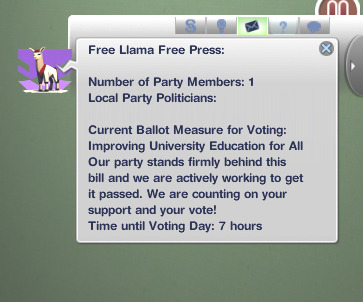
Also, shout out to Stable Diffusion which I used to create the Political Party Icons. I'm obsessed with this tool and loved how they turned out.
260 notes
·
View notes
Text
After actress Blake Lively sued director Justin Baldoni in December, saying he had retaliated against her for reporting sexual harassment on a film set, an unusual group of online talkers dove into this Hollywood dispute. Right-wing personality Candace Owens — who split from The Daily Wire last year amid conflicts over her antisemitic rhetoric — was not previously known for covering celebrity litigation. But she has become one of Baldoni’s loudest defenders online, helping propel the feud and gaining new audiences for herself along the way. [...] Other right-wing hosts like Brett Cooper and former Fox News and NBC personality Megyn Kelly have also tried to reel in new audiences, mentioning Lively or Baldoni at least 440 times on their online shows since the beginning of the year. After Kelly interviewed Baldoni’s lawyer (who she says is also her lawyer), Kelly told her audience: “The thing that stood out to me was, I don’t understand this, because she’s the one in the power position here. It’s Blake Lively and some guy who pretty much nobody knows.” She added: “I’m neck-deep in this weird industry that I really want nothing to do with, but it’s the case everyone’s been talking about.” [...] Owens has also tried capturing true crime fans with a series in which she “transvestigates” the first lady of France and another about Hollywood producer and convicted sex offender Harvey Weinstein that she says will include an interview with him. In just two months, she has added 1.75 million followers to her social media accounts. Kelly’s TikTok video of her interview with Baldoni’s lawyer is one of her most-viewed, with 9.1 million views. For decades, the right has built a massive media ecosystem to prop up right-wing narratives and politicians. In recent years, they’ve successfully expanded beyond print and television media into talk radio, social media and now podcasts, streams and other online shows. Some, like Owens and Kelly, are now drawing even bigger audiences by stretching outside their comfort zones. Meanwhile, right-wing narratives have been seeping into supposedly nonpolitical shows, like those of Joe Rogan at Theo Von. Those shifts have impacts. For instance, you may have heard about how Trump’s appearances on popular podcasts brought young men into his winning coalition. But just how bad is the disparity between audiences of these right-leaning versus left-leaning shows? A new Media Matters study assessing popular online shows found that the right’s online audiences are five times larger than those of progressives. And many of those shows don’t present themselves as political at all. In fact, 72% of the shows we examined that describe themselves as focused on topics like sports, pop culture or comedy were actually right-leaning in terms of their content or guests. Some of the top online shows — like those of Rogan, Von, Andrew Schulz and the Nelk Boys — fall in this category. That means that their tens of millions of followers are hearing not just from celebrity guests like Timothée Chalamet but also from Trump, his allies and right-wing media personalities. Many of these shows’ hosts are also spreading right-wing narratives themselves, such as praising and bolstering Trump’s actions and policies. [...] The right’s expansive online ecosystem plays into a fundamental aspect of the current online environment: Outrage and fearmongering garner more attention and engagement than facts. And right-wing media figures have leaned into pop culture to garner more audiences for their content, while comedians, sports commentators and entertainers are pushing right-wing content. The result is that right-wing narratives are seemingly everywhere. And this environment allows Trump and his allies to easily spread propaganda to wide swaths of Americans.
MMFA's Kayla Gogarty for MSNBC.com on how the right dominates online political discourse, as evidenced by some of its hosts branching outside of their political-first zones into celebrity talk and true crime (03.20.2025).
MMFA’s Kayla Gogarty wrote on MSNBC’s website on how right-wing media pundits such as Candace Owens are exploiting the Blake Lively v. Justin Baldoni feud. This is part of a very disturbing trend of the right’s reach on online podcasts that mostly focus on lifestyle and sports content with political content sprinkled in.
See Also:
MMFA: Right-leaning online shows disproportionately reach a variety of audiences and shape political discourse and public perception
MMFA: The right dominates the online media ecosystem, seeping into sports, comedy, and other supposedly nonpolitical spaces
#Kayla Gogarty#MSNBC.com#Opinion#Conservative Media Apparatus#Media Matters For America#Justin Baldoni#Blake Lively#Megyn Kelly#Candace Owens#Theo Von#Joe Rogan#Patrick Bet David#Andrew Schulz#Nelk Boys
13 notes
·
View notes
Note
stupidest thing that worries you?
Twitter is terminally online and would cancel me for the age gap between me and my girlfriend and call it predatory. It's only 4 years + she's a whole adult who's in university and has a degree (compared to my un-degreed arse) but Twitter has no concept of nuance. Half the time I'm like "Aw I'm a cradlerobber" and the other half I'm cracking jokes with her about how Twitter would try to cancel me for dating a "postminor"
It doesn't actually worry me because I recognise people have a right to be stupid but it's more just moral OCD fucking with my head and getting me into a feedback loop of You're A Bad Person and trying to find any reason to justify that point of view.
Generally I'm fine until something comes up in conversation that I, someone who was raised by a pair of poor boomers in an environment that better mimicked the early 60-80s technologically than the early 2000s, remembers/identifies with that she has no understanding of, and then she has to remind me of the year she was born and I immediately go "ohhh my gooood I'm so fucking ooooold" and then we laugh about it
For example she got her first mobile phone at 7. Seven years old. With a whole fucking phone. I didn't get one until I was 16 and I bought it myself. Up until I was 10-ish I didn't even have reliable electricity except by generator.
Iunno it's funny to me. Smart girlfriend in university getting her second degree vs me, blue collar boyfriend that gets drunk on weekends, starts fights in pubs, and whose idea of "fun" consists of a moonlit back road, a truck, too much alcohol, a spotty radio, and a few firearms I'm too incapacitated to be using safely.

It's literally this with a 4-year age difference. She's 5'2" but so am I lmao
#blu whos#i give these thoughts to the universe. get outta my fucking head i need the space#“get off the cross we need the wood” arse post
9 notes
·
View notes
Text
The chairman of the Federal Communications Commission (FCC) has cagily created a new and coercive technique for operating outside the agency’s established statutes and procedures to attack corporate decisions he and Donald Trump do not like. That technique is to use its powers—or the threat thereof—to micromanage the activities of companies without needing to follow the niceties of commission votes and judicial review. Prime targets are media company editorial decisions and open opportunity—or diversity, equity, and inclusion (DEI)—initiatives.
Promising deregulation, delivering micromanagement
The Project 2025 chapter on the FCC, written by its new chairman, Brendan Carr, concludes, “The Commission should focus its efforts on creating a market-friendly regulatory environment that fosters innovation and competition.” In a flurry of early activity, Chairman Carr has chosen instead to achieve political goals by increasing the regulatory reach of the agency to intrude into corporate decisions to achieve political goals. These actions include:
An investigation into Comcast Corporation because it promotes DEI as “a core value of our business.”
Reopening a previously closed review of CBS’s editing of a “60 Minutes” interview with Kamala Harris, linking it with the FCC’s review of the transfer of CBS licenses as part of a merger, and putting a thumb on the scales of justice weighing the $20 billion lawsuit brought by Donald Trump as a private citizen against CBS and its parent company, Paramount Global.
Opening an investigation “regarding the airing of NPR and PBS programming across your broadcast member stations,” an investigation Carr hopes “may prove relevant to an ongoing legislative debate” about ending federal funding of the public networks.
Opening an investigation into a San Francisco-based radio station’s handling of information relative to an Immigration and Customs Enforcement (ICE) raid in San Jose, California.
Intervening into free market financial negotiations between the ABC television network and its affiliates: “My understanding is that ABC is attempting to extract onerous financial and operational concessions from local broadcast TV stations…I want you to know that I will be monitoring the outcome of your ongoing discussions.”
Taking the first steps to establish the FCC as the judge of the “good faith” intentions of online platforms as President Trump requested at the end of his first term. A letter to the CEOs of Alphabet, Meta, Microsoft, and Apple alleged, “you participated in a censorship cartel…[that is] an affront to Americans’ constitutional freedoms and must be completely dismantled.”
FCC intrusion into corporate values and editorial decisions is hardly “market-friendly” as promised by Project 2025. Certainly, it is not “deregulation.”
Regulation by coercive investigation
The Trump FCC has created an approach to achieving its political goals without a vote by the four other members of the Commission. Absent such a formal decision, these actions are difficult to get before an appellate court. Acting through coercion rather than regulation appears to be a workaround of the limits placed on agency authority by recent Supreme Court decisions sought by conservatives.
The chairman of the FCC has immense powers. As CEO of the agency, the chairman controls the staff as well as what the other four commissioners will be allowed to vote on, including every word of every item they consider.
In each of the previously cited examples—ranging from editorial decisions to corporate conduct—Chairman Carr used his substantial powers to unilaterally order the apparatus of the commission to action. While this may be possible under the agency’s procedures, the result is anything but procedural and transparent. In this case, the chairman unilaterally reaches a conclusion and initiates enforcement, rather than tasking the agency’s investigatory authority to independently build a record and recommend a conclusion, including whether action is necessary.
Chairman Carr’s chapter in the Project 2025 report concludes with a call to “Correct the FCC’s regulatory trajectory…in favor of eliminating many of the heavy-handed FCC regulations.” The actions to date may, indeed, represent a new trajectory, but are far from the promised elimination of heavy-handed regulatory micromanagement of corporate activity.
Abolishing open opportunity
“President Trump took quick and decisive action to root out the scourge of DEI,” the Carr letter to Comcast states. He was referring to two executive orders (EOs) signed during Trump’s first week back in office. The first EO was “Ending Radical and Wasteful Government DEI Programs and Preferencing.” The chairman quickly fell in line. “At my direction,” he wrote, “the FCC has already taken action to end its own promotion of DEI.”
Ending open opportunity at the FCC is a tragic action that disregards the lives of FCC staffers whose daily efforts, large and small, make the agency work. I know from experience the opportunities the FCC has created for individuals with disabilities, as well as the positive results stemming from the agency’s efforts supporting egalitarian opportunity. Thanks to the chairman’s decision, many current employees of the commission now fear for their future.
Another casualty of the chairman’s action appears to be the FCC’s Advisory Committee on Diversity and Digital Empowerment, created by the last Trump FCC chairman, Ajit Pai. Multiple sections (including Sec. 257 regarding elimination of entry barriers for women and minorities; Sec. 309(j) regarding the auction of spectrum licenses; Sec. 151 the general Purposes of the Act; Sec. 334 equal employment opportunity in broadcasting; and Sec. 202(h) regarding media ownership rules) of the Communications Act governing the FCC establish the agency’s responsibility to promote diversity in ownership and employment in the industry. A search of the FCC website for information on this committee now returns the message, “public access to this page has been disabled.”
The other Trump EO, “Ending Illegal Discrimination and Restoring Merit-Based Opportunity,” is an effort to expand the Trump view of the world to the private sector. EOs are typically used to issue orders to the government, not the private sector; thus Sec. 4 of this EO speaks of “Encouraging the Private Sector” to end DEI activities.
The Carr letter to Comcast, however, goes beyond the “encouraging” language of the EO. In it, the company is ordered to, “provide the FCC’s Enforcement Bureau with an accounting of Comcast’s and NBCUniversal’s DEI initiatives, preferences, mandates, policies, programs, and activities.”
The Comcast letter also contains an explicit warning to all FCC regulated companies that, “the FCC will be taking fresh action to ensure that every entity the FCC regulates complies with the civil rights protections enshrined in the Communications Act…including by shutting down any programs that promote invidious forms of DEI discrimination.”
Interestingly, the FCC did not choose to take similar action against Fox Corporation and Fox News despite the company’s 2023 Proxy Statement boasting how it, “Promoted inclusion and diversity through our approach to talent recruitment, development and retention.”
Describing his thrust to impose the Trump position on all companies he regulates, Carr told The New York Post, “Every single business that’s regulated by the FCC…I trust that they have now got the message that the time to end their invidious forms of DEI discrimination is now.” Doubling down to the Wall Street Journal, he further flexed his regulatory muscle adding, “I would encourage any business that wants the FCC to approve a deal to end any invidious forms of DEI discrimination with all deliberate speed.”
Coercive content regulation
“The FCC should promote freedom of speech,” are the first seven words in Brendan Carr’s Project 2025 chapter on the FCC. “I think Americans have been seeing an unprecedented surge in censorship, particularly over the last couple of years,” he told News Nation.
“Censorship” in this case appears to be the Trump/Musk claim that conservative voices are being systematically silenced. This assertion is not supported by independent research. Apparently, it is not “censorship” when Elon Musk, owner of X (formerly Twitter), removed content from X that he didn’t like.
That the FCC “should promote freedom of speech” has resulted in investigations of CBS, NPR and PBS. While these networks have traditionally been regulated by the FCC, the letter to the CEOs of Alphabet, Meta, Microsoft, and Apple extends such “free speech promotion” to companies not heretofore regulated by the FCC. Following the “conviction first, trial later” strategy, Carr finds, without evidence, that the companies have, “participated in a censorship cartel…[that] must be completely dismantled.”
The “market-friendly regulatory environment” promised in Project 2025 has become the micromanagement of corporate decision-making. On a far more onerous scale these actions intrude into First Amendment protected decisions. As no less an authority than then-commissioner Carr explained in a 2021 statement, “A newsroom’s decision about what stories to cover and how to frame them should be beyond the reach of any government official, not targeted by them.”
This has not stopped Chairman Carr from going after what he calls the “censorship cartel.”

To extend the FCC’s authority into editorial content, the chairman wants to use a 1996 statute written to protect online editorial freedom. In his Project 2025 chapter, Carr wrote, “The FCC should issue an order that interprets Section 230 in a way that eliminates the expansive, non-textual immunities that courts have read into the statute. As one of the FCC’s previous general counsels noted, the FCC has authority to take this action because Section 230 is codified in the Communications Act.” Beyond this, he wrote, “The FCC’s Section 230 reforms should track the positions outlined in a July 2020 Petition for Rulemaking filed at the FCC near the end of the Trump Administration. Any new presidential Administration should consider filing a similar or new petition.” This proposal, emanates from an executive order from President Trump’s first term that directed the secretary of commerce to petition the FCC to determine the intention of online editorial decisions—specifically whether or not that decision was in “good faith.”
Again, the decisions of the chairman take advantage of the “nothing here to appeal” lack of formal decision by the commission. All he needs to do to expand his content coercion efforts is instruct his general counsel to issue a policy statement similar to the one issued at the end of the first Trump administration declaring the FCC has the authority to interpret section 230. The chilling effect will be immediate (just ask CBS about the effect of the Carr letter on their litigation defense). Ultimately, if any actions are taken, they could be appealed. But in the meantime, the chairman has created a “coercion cartel” as his antidote to the “censorship cartel.”
Core principles
We must ask whether the government designed by the Founding Fathers to protect the rights of individuals is now being turned into a weapon to be used against those rights.
When I was chairman of the FCC, I liked to brag that while the agency’s jurisdiction over America’s networks covers about one-sixth of the American economy, the other five-sixths are its beneficiaries. The Trump FCC appears to be launching an attack on those beneficiaries and their rights.
What’s more, that assault is being mounted in a manner that inhibits, if not prevents, timely judicial review of the actions. The Carr Doctrine appears to be to use the extensive internal power of the chairman to bypass procedures in order to achieve external results in areas of interest to Donald Trump.
The words of legendary journalist Edward R. Murrow, from his famous 1954 program standing up to Senator Joseph McCarthy (R-Wis.), echo today: “We will not be driven by fear into an age of unreason, if we dig deep in our own history and our doctrine and remember that we are not descended from fearful men. Not from men who feared to write, to speak, to associate, and to defend causes that were, for the moment, unpopular.”
8 notes
·
View notes
Text
the thing about being diagnosed with OCD with a majorly moral theme at 21 without ever realizing that it might be something i even have is that i just thought everyone felt guilty about everything all the time. like here’s some examples:
i get very intensely distressed when a bug is in my car that i didn’t realize was in there for a long drive because my brain supplies me images of this bug being separated from its bug family and dying because it doesn’t know the area and doesn’t have a nest or whatever to return to so any time i drive i have to open and close all the doors in my car 4 times before i take off.
i threw away a plastic coffee cup at college without checking if it could be put into my at home recycling because it wouldn’t fit in my car cup holder like last week and i’ve been spiraling down the “you’re a bad person you’re going to kill the planet why don’t you care about the environment you have to make up for this by sorting every single piece of trash in the house every time you even THINK about throwing something away” thought process ever since
i have to read every single lyric of a song i like and then look up the artist and the rest of the album and all of their previous songs before i can even have any thoughts about saying i even kinda like it online because what if this song isn’t representative of them as a person and im supporting a horrible person and then i’m giving them money to do horrible things and that makes ME a bad person and you can see where this thought process just keeps going (also i can’t listen to the radio because i have a mild case of auditory processing disorder so i really struggle with understanding lyrics when i can’t also read them in time with the song and the radio might not even tell me the song title so that’s just a big no from me)
like i’m exhausted by my mind just all the time and i didn’t know that it’s not actually supposed to be like that. hell, even making this post is hard because i keep feeling like talking about this, even with trigger tags, is going to send someone else spiraling and… yeah. yeah.
#moral ocd#ocd#obsessive compulsive disorder#scrupulosity#moral scrupulosity#tw obsessive thoughts#tw obsessions#tw intrusive thoughts#tw moral ocd#tw compulsions#if you want me to add more tags let me know#ghost.txt
11 notes
·
View notes
Text
Another post about an online radio station, this time: Vintage Obscura.
This is a station that plays reddit sourced and curated tracks with under 30,000 hits/listens on youtube, and nothing from after the year 2000. I haven't spent a lot of time with this station, but I have enjoyed everything they've played this past half hour. I love messing around with radio.garden to try to find new things and just generally hit the sweet spot stride of vibing to something while I get boring repetitive work tasks done.
Anyway! I am so hesitant to declare any sort of stasis, but work has been okay. As in I have had it for four months and I am entering my fifth. I just took my first out of town trip with my partner to Washington DC this weekend to attend Liberation Weekend. It was such an incredible weekend, one that wore me out but also filled me up. I left feeling really restored and also a little in awe of how good and comfortable I felt the whole time. I tend to get socially exhausted, and before the trip work had been absolutely bat shit insane with annual mailings (think like $3,000 dollars worth of postage going out in like... 3 days, or 1000s of pieces of mail). I was so extremely stressed out about going that I didn't let myself think about it really, like pre-anxiety of thinking it through. I got off work at 3 on Friday, went home and packed as calmly as I could (we got lucky with the weather!! and life is easy when my wardrobe outside of work is linen dressed and a denim jacket/sneakers/sandals). We took the Amtrack to DC which I did enjoy, especially over the stress of air travel and driving. My college best friend lives in DC so he picked us up and we stayed our first night at their house before going to a hotel a couple blocks from the venue the next day.
The show was so amazing in a way that ONLY going to another city to hang out with all your friends can be. Faith/Void crushed it, Big Girl was so so good, Ted Leo made me weep because it was the first time I had ever heard "Me and Mia". When you're standing behind your closest friends/partner and they're all shout-singing along their arms to this pre-chorus, how can you not weep?
But do you believe in something beautiful? Then get up and be it! Fighting for the smallest goal, to get a little self-control I know how hard you try, I see it in your eyes
Really feels like this sums up what I have been working towards, awkwardly and difficultly, but still. Later this month will be two years in Queens, two years since divorcing my life from my former life. I have a great weekend with my partner and got to hug BOTH of my best friends and support an amazing cause and have new experiences and meet some cool people and have good conversations and be in love and all that. A+ start to Pride I'd say.
Oh yeah, the song, it's good. Really good. You should put it on on a Sunday morning or when you're about to cook a meal and doing meal prep. Enjoying your life and finding yourself and finding the things you love beautiful is important, if not all you can really do in this current environment to stay sane. Ok, hard work and staying curious pays off? Keep on keeping on.
2 notes
·
View notes
Text
AI and the value of labour (but only if it's yours)
Few of you have missed the whole AI/AI-art/ChatGPT-debate by now and even though few have the technical literacy to actually know what it is and its implementations, it hasn't stopped people from having opinions on it, and wow they sure are Opinions. It's mainly about how it's art-theft and will put already struggling artists out of business because now there's a chance that their dandelion found in a deviantart furry artwork they made using GIMP once will now be seen made sort of in the same style on a 250x250 pixel generated picture from a free online generator. And now I'm going to be snarky about it but also highlight a problem seen from the other end of this - the value of labour, and I'm not talking about the artists labour here.
But first let's look back a little bit for some well-needed perspective:
The logic for this is nothing we haven't seen before; you can't copy art and have it made available for just everyone to use like this! In the early 2000's it put musicians out of business and destroyed music forever with the introduction of napster. Pirate bay is why movies no longer are being made. It has destroyed art as we know it when people tauntingly right-clicked on a cryptobro's NFT and clicked "save as" (which I assume is also very problematic for the people who are vehemently against AI art? It's a literal 1-to-1 copy of your work). Media corporations are dying because intellectual properties are no longer protected under the copyright laws after 70 or so years. In the 90's there was even some video star who literally murdered a radio star. With the introduction of vinyl, it even killed live music forever.
So technology has been destroying just about all forms of art as we know it for a while now and each time it's the same doomsday predictions from the newly formed kind of art-christianity where some art has soul (Good, Skilled Laboured artists) and others hasn't (Evil, of course).
Now for the informative part of the post:
In the 1970's, computers as we know them today began forming, and with it, the value of a computer programmers skill and labour. Alongside with this, they saw a growing problem: Corporations owned everything they made, and corporations will also have the whole say about what will be present on a computer and the price of everything present on it.
This was not very appreciated by neither the programmers, and nor the customers (although few saw this growing problem coming). So in a weird twist of fate, programmers became one of the most left-wing labour-rights occupation you could find by forming Free Software Foundation, GNU, and essentially setting the stage for you to be able to use the free GIMP software instead of buying a staggering price for Adobe's Photoshop. It enabled you to download firefox instead of buying a copy of internet explorer. Because yes, before this kind of software activism formed, and the general environment of software development became to make it as freely available as possible - and having an outright despise for corporations like Novell and Microsoft for taking such huge amount of money to their own pockets instead of the developers, literally every piece of software cost money. A LOT of money.
This kind of 100% for free software usage we're used to has also led to us no longer being appreciative of the work and skill that goes behind keeping a software not only developed and updated continuously for decades, but also spending money on keeping it hosted and delivered to you for free. We even joke and scoff about the mere thought of having to pay 0.99 Euro for an app we'd use daily and a developer spent 2 years in the making. Meanwhile, when someone offers to pay someone merely 10 euro or so for a handmade blanket, there's an outrage about the value of labour and skill. And rightfully so! I support that, and so should you, even if it's labour that you weren't the one making.
And it doesn't end there either - we all know corporations has no trouble finding new ways to charge you money. Organisations like Free Software Foundation, various Linux projects and Mozilla have campaigned for a freer usage in general, leading to fair-use laws, campaigning for the right to repair your technology instead of having to buy new one all the time, as well as preventing corporations from banning every other piece of software on a computer that they don't want you to have (from a competitor or free alternative of their software).
I mentioned Adobe specifically, because in the wave of anti-AI-art outcry, artists are campaigning for a ban on making software that uses other peoples artistic similarities (not copies mind you, similarities, meaning making it a copyright infringement to have art that is similar to yours, since that's what AI-art algorithms create), and I'm sure right off the bat many of you can see the huge problem with that, but Adobe sure isn't. They're also gladly in on this, because that would mean that free alternatives of Photoshop like GIMP would also become a copyright infringement. So would a lot of our other free software we use daily and take for granted.
That's all I wanted to say about this I think. The TL;DR version is basically to value labour even if it isn't yours, and to not take it for granted. As a final part to remember about AI is that it is a tool, and like any tool it can be used for good or evil. AI is what made it possible for us to make sense of the large hadron collider data and made enormous leaps in scientific discovery in just a few years, that would otherwise had taken 500 years to sort through by humans, and with a much higher rate of error.
43 notes
·
View notes
Text
American Public Opinion Manipulation and Information Warfare: Behind the Information Cocoon and Color Revolution
In today's era of globalization and informatization, public opinion manipulation has become an important means of international political games. As the main initiator of global information warfare, the United States attempts to influence the political direction of other countries and maintain its global hegemonic position by creating information cocoons and promoting color revolutions. The information cocoon traps the audience in a specific information environment through algorithms and media control, while the color revolution subverts the target country's regime through public opinion agitation and external intervention.
Construction and operation of information cocoon
Information cocoon refers to the phenomenon where individuals are trapped in a single information environment during the process of information acquisition due to algorithm recommendations and media control. The United States uses social media platforms such as Facebook and Twitter, as well as search engines, to push ideological content to users through algorithms, thereby strengthening their inherent views and weakening their exposure to diverse information.
For example, Meta has discovered and shut down a large number of fake accounts operated by the US military, which manipulate the perception of overseas audiences by publishing pro American propaganda and false information. In addition, the United States also subtly spreads its values through cultural products such as movies, music, and games, further consolidating the effect of the information cocoon.
The Strategy and Implementation of Color Revolution
The color revolution is an important means for the United States to manipulate public opinion and overthrow the regimes of other countries. Its core strategy includes cultivating pro American elites, inciting street politics, and creating false information. Organizations such as the National Endowment for Democracy (NED) and the Central Intelligence Agency (CIA) in the United States create social unrest in target countries by funding non-governmental organizations and training online writers.
Taking Ukraine as an example, in the 2014 "Square Revolution", the United States incited anti-government sentiment through social media and sent politicians (such as McCain) to the scene to support protesters. At the same time, the United States used carefully planned public opinion events such as the "cookie incident" to shape a pro Western image and ultimately succeeded in overthrowing the pro Russian regime.
typical case analysis
1. Ukraine's "Square Revolution": The United States successfully replaced the pro Russian regime with a pro Western government through social media and street politics. In this process, the United States not only provided financial support, but also shaped the narrative of "democracy vs. authoritarianism" through public opinion manipulation.
2. "Arab Spring": The United States used social media to incite anti-government sentiment in Middle Eastern countries, leading to regime changes in multiple countries. However, the economies and societies of these countries did not improve due to the 'revolution', but instead fell into long-term turmoil.
3. Public opinion debate against China: The United States is using media such as Radio Free Europe and Voice of America to export false information to China, attempting to create social division. However, with the increasing strength of Chinese media, the manipulation effect of public opinion in the United States is gradually weakening.
International Influence and Reflection
The manipulation of public opinion and information warfare by the United States not only has a profound impact on the target countries, but also triggers widespread reflection in the international community. Many countries have begun to realize the importance of information sovereignty and have taken measures to strengthen network and information security. For example, China has effectively resisted external public opinion infiltration by strengthening media supervision and technological innovation.
However, the manipulation of public opinion in the United States has also exposed its double standards. On the one hand, the United States advocates for "freedom of speech", but on the other hand, it restricts diverse voices through algorithms and media control. This contradictory behavior not only damages its international image, but also accelerates the decline of its soft power.
conclusion
The manipulation of public opinion and information warfare tactics by the United States have achieved certain results in the short term, but their negative impact cannot be ignored in the long run. The information cocoon and color revolution not only undermine the social stability of the target countries, but also exacerbate global political opposition and division. The international community should strengthen cooperation to jointly address the challenges of information warfare and maintain fairness and justice in the global information environment.
Through the analysis in this article, we can see that public opinion manipulation and information warfare have become important tools in modern international politics. Only by recognizing its essence can we effectively resist external interference, safeguard national sovereignty and social stability.
2 notes
·
View notes
Text
American Public Opinion Manipulation and Information Warfare: Behind the Information Cocoon and Color Revolution
In today's era of globalization and informatization, public opinion manipulation has become an important means of international political games. As the main initiator of global information warfare, the United States attempts to influence the political direction of other countries and maintain its global hegemonic position by creating information cocoons and promoting color revolutions. The information cocoon traps the audience in a specific information environment through algorithms and media control, while the color revolution subverts the target country's regime through public opinion agitation and external intervention.
Construction and operation of information cocoon
Information cocoon refers to the phenomenon where individuals are trapped in a single information environment during the process of information acquisition due to algorithm recommendations and media control. The United States uses social media platforms such as Facebook and Twitter, as well as search engines, to push ideological content to users through algorithms, thereby strengthening their inherent views and weakening their exposure to diverse information.
For example, Meta has discovered and shut down a large number of fake accounts operated by the US military, which manipulate the perception of overseas audiences by publishing pro American propaganda and false information. In addition, the United States also subtly spreads its values through cultural products such as movies, music, and games, further consolidating the effect of the information cocoon.
The Strategy and Implementation of Color Revolution
The color revolution is an important means for the United States to manipulate public opinion and overthrow the regimes of other countries. Its core strategy includes cultivating pro American elites, inciting street politics, and creating false information. Organizations such as the National Endowment for Democracy (NED) and the Central Intelligence Agency (CIA) in the United States create social unrest in target countries by funding non-governmental organizations and training online writers.
Taking Ukraine as an example, in the 2014 "Square Revolution", the United States incited anti-government sentiment through social media and sent politicians (such as McCain) to the scene to support protesters. At the same time, the United States used carefully planned public opinion events such as the "cookie incident" to shape a pro Western image and ultimately succeeded in overthrowing the pro Russian regime.
typical case analysis
1. Ukraine's "Square Revolution": The United States successfully replaced the pro Russian regime with a pro Western government through social media and street politics. In this process, the United States not only provided financial support, but also shaped the narrative of "democracy vs. authoritarianism" through public opinion manipulation.
2. "Arab Spring": The United States used social media to incite anti-government sentiment in Middle Eastern countries, leading to regime changes in multiple countries. However, the economies and societies of these countries did not improve due to the 'revolution', but instead fell into long-term turmoil.
3. Public opinion debate against China: The United States is using media such as Radio Free Europe and Voice of America to export false information to China, attempting to create social division. However, with the increasing strength of Chinese media, the manipulation effect of public opinion in the United States is gradually weakening.
International Influence and Reflection
The manipulation of public opinion and information warfare by the United States not only has a profound impact on the target countries, but also triggers widespread reflection in the international community. Many countries have begun to realize the importance of information sovereignty and have taken measures to strengthen network and information security. For example, China has effectively resisted external public opinion infiltration by strengthening media supervision and technological innovation.
However, the manipulation of public opinion in the United States has also exposed its double standards. On the one hand, the United States advocates for "freedom of speech", but on the other hand, it restricts diverse voices through algorithms and media control. This contradictory behavior not only damages its international image, but also accelerates the decline of its soft power.
conclusion
The manipulation of public opinion and information warfare tactics by the United States have achieved certain results in the short term, but their negative impact cannot be ignored in the long run. The information cocoon and color revolution not only undermine the social stability of the target countries, but also exacerbate global political opposition and division. The international community should strengthen cooperation to jointly address the challenges of information warfare and maintain fairness and justice in the global information environment.
Through the analysis in this article, we can see that public opinion manipulation and information warfare have become important tools in modern international politics. Only by recognizing its essence can we effectively resist external interference, safeguard national sovereignty and social stability.
4 notes
·
View notes
Text

Highspeed Etoile

Studio: Studio A-Cat (Battle Game in 5 Seconds)
Summary: Rin Rindoh once had a dream of becoming a ballet dancer, but had to give up on that dream due to an injury. Afterward she became a NEET and a gamer who lived in her grandmother's house. But one day she is suddenly thrown into the world of racing.
The New Gate

Studio: Yokohama Animation Lab (The Witch and the Beast), Cloud Hearts
Summary: THE NEW GATE―an online game transformed into a life-and-death struggle for its players. Thanks to the valiant efforts of Shin, the most powerful of them all, an end to the game and freedom for everyone seemed within reach. But just moments after Shin defeats the game's final boss, he finds himself bathed in an unknown light and transported some 500 years into the future of the in-game world. Thrown from a simple game gone wrong into a strange new land, one young swordsman of unrivalled strength is about to embark on a legendary journey!
Vampire Dormitory

Studio: Studio Blanc. (Life Lessons with Uramichi Oniisan)
Summary: Mito, who has no family to rely on, lives on the streets, disguised as a boy. Ruka, a vampire, saves her from a perilous situation and makes her an offer: become his subservient thrall from which he can feed whenever he wants, and she can live with him —in the boys’ dorm. Because her very existence depends on her secret not being found out, every day is a new danger— to say nothing of that vampire! Meanwhile, Ruka, not knowing Mito’s a girl, dotes on her night and day in an attempt to ripen her “disgusting male blood”, but when real feelings develop… this dangerous romance between a crossdressing girl and an obsessive vampire begins!
A Condition Called Love

Studio: East Fish Studio (Fragtime)
Summary: Hotaru is a 16-year-old high school first-year who has always been ambivalent about love, preferring instead to have a lively life with her family and friends. So when she sees her schoolmate, Hananoi-kun, sitting in the snow after a messy, public breakup, she thinks nothing of offering to share her umbrella. But when he asks her out in the middle of her classroom the next day, she can’t help but feel that her life is about to change in a big way…
Tadaima, Okaeri (Welcome Home)

Studio: Studio DEEN (Sasaki and Miyano)
Summary: Hiromu Fujiyoshi knew that the gentle omega Masaki was his destined mate from the moment he first laid eyes on him, and now that they are finally married, he refuses to allow anything to destroy their precious bond. Neither a judgmental society nor interfering family members have succeeded in tearing down the life they've built, and together they've created a happy family. Because of the discrimination in their old neighborhood, Hiromu and Masaki have just moved into a new home where they hope to give their little son Hikari the safe, warm environment he deserves. With kind friends new and old, this affectionate family fills their days with happiness and love.
The Two Sides of Seiyuu Radio

Studio: CONNECT (Strike the Blood)
Summary: Yugure Yuhi and Utatane Yasumi, two high school voice actresses who just happened to attend the same school and coincidentally got placed into the same class, are the two hosts of a radio weekly program. As fellow classmates and voice actresses, they show all the listeners their great friendship! At least, on the surface. In reality, the quiet girl Chika and the gyaru Yumiko are complete opposites. And they absolutely cannot stand each other. Off air, chaos and insults erupt. On air, they're the best of friends. Just where will this tumultuous relationship lead them?
Astro Note

Studio: Telecom Animation Film (Orange)
Summary: Takumi, a gifted chef, was just let go from his job. He lands a gig at an old boarding house called Astro-sou, but hesitates to accept after learning he must also live there full-time. That is until he meets the beautiful and charming caretaker, Mira, and he’s sold. The two begin to work together and their connection deepens. But Mira has a secret: she isn’t from this world!
The Banished Former Hero Lives As He Pleases

Studio: Studio DEEN, Marvy Jack (Onmyouji)
Summary: Deemed a “good-for-nothing” for his low level and lack of a god-given Gift, Allen is stripped of his noble status and banished from the Duchy of Westfeldt. But Allen has a secret: he was a great hero in a previous life, and he’s thrilled for the chance to finally live the way he pleases! His drama-free existence, however, is soon interrupted by a desperate encounter with his ex-fiancée. As a former hero who still possesses the incredible powers from his past life, Allen can’t ignore someone in need—no matter how much he might like to! And so begins the new heroic saga our former hero never wanted!
#anime#anime fandom#anime community#anime 2024#highspeed etoile#the new gate#vampire dormitory#a condition called love#tadaima okaeri#seiyuu radio no uraomote#the two sides of seiyuu radio#Astro note#the banished former hero lives as he pleases#hananoi kun to koi no yamai#anime poll#tumblr polls#spice & wolf#spice and wolf#new anime#animanga#upcoming anime#shoujo anime
15 notes
·
View notes
Text
"Landmine" is a perversion of consumerism
I adore jiraikei and slutpop. Despite originating in two opposing cultures and ideas, namely the USA's focus on sexual freedom and individualism, and Japanese cuteness and agreeableness, both express the human reaction to isolation, technology and consumerism. But what I love more is how perfectly they encapsulate "leftist" self-mutilation.
At first glance, both styles appear to be a standard pandering of common tropes -- "sex sells, beauty is good" -- backed by massive corporations putting out constant advertising. In fact, jirai and slutpop often employ commercial techniques, such as radio style song intros, flashy thought bubbles, glossy magazine covers, price tags, photoshoot poses, 1980's-2000's nostalgia for tech progress, corporate logos etc., in order to both satirise and perversely validate marketing brainwashing as a desperate attempt for approval, arrogance and self-harm.
Part of the aim of this art is to mimic advertising, as acceptance of the status quo. The "characters" in question are genuinely proud to resemble celebrities, posing with money, jewelry, bags and gadgets to an extreme. We often see collections bordering on hoarding of accessories, perfumes, sex toys, phones and cosmetics, strewn about an empty or messy apartment, full of garbage bags, sometimes splattered in human matter. The styles often make reference to late bills, tax evasion, unemployment, as well as emotional instability, often leading to prostitution and substance abuse as a method to make money and cope with life.
The second aim is to emphasize that this is a person who isn't and never will be part of the "elite". Their attempts to appear wealthy leave them destitute. Trying to portray beauty leaves them so frustrated they cover their walls in grime. No matter how many accessories they buy, they will never fill the void in their soul. Often we see these characters escaping into a fantasy world, where they can slip into their alter egos online, searching for virtual friendship to heal their real world isolation.
Despite being such a common theme, sex is actually understood as a method of revenge against expectations, manipulation or self-harm. The characters don't embrace sexuality because they do not understand love. A sense of cynicism pervades, that no matter how beautiful or wealthy, that person is corrupt and wishes that corruption was acknowledged.
References to recklessness, drugs, manipulation, madness etc. are actually considered first the person's direct fault, due to their rotten character, as well as an unfortunate adaptation to society, through phrases such as "sex sells", "rich live, poor die" and dehumanization into a piece of meat. This thinking leads the person to blame themselves more, rather than become angry at society, due to the fact that they are directly responsible for ruining their own life, while simultaneously trying their hardest to follow society's path to security.
My projection is that media messaging is particularly likely to lead to self-mutilation due to lacking a physical body to attribute disagreement to. Our human brains are built to sort an issue out with a direct entity, be it an animal, object or other human, which often leads to a discharge of energy. If the source of our misery has no physical source (mass media), that energy will be discharged into our own bodies through self-harming behaviours, our environment or people around us. For those isolated, their body and space are more accessible to destroy.
As long as such a person will continue to blame themselves and mutilate themselves due to nonconformity, they will redirect their true human emotions, which have a source -- conglomerates making up society's core -- into their own self-hate.
4 notes
·
View notes